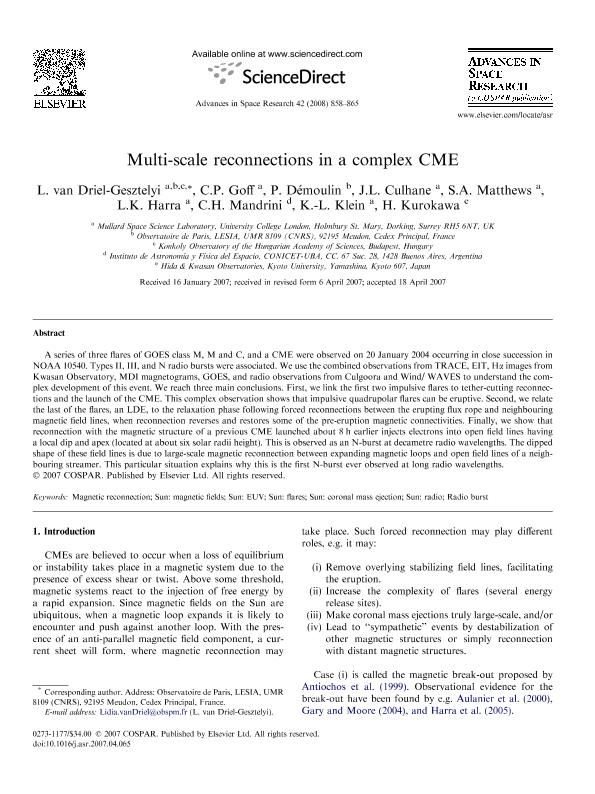Mostrar el registro sencillo del ítem
dc.contributor.author
van Driel Gesztelyi, Lidia

dc.contributor.author
Goff, C. P.
dc.contributor.author
Démoulin, Pascal

dc.contributor.author
Culhane, J. L.
dc.contributor.author
Matthews, S. A.
dc.contributor.author
Harra, L. K.
dc.contributor.author
Mandrini, Cristina Hemilse

dc.contributor.author
Klein, K. L.
dc.contributor.author
Kurokawa, H.
dc.date.available
2017-07-17T18:04:18Z
dc.date.issued
2008-09
dc.identifier.citation
van Driel Gesztelyi, Lidia; Goff, C. P.; Démoulin, Pascal; Culhane, J. L.; Matthews, S. A.; et al.; Multi-scale reconenctions in a complex CME; Elsevier; Advances in Space Research; 42; 5; 9-2008; 858-865
dc.identifier.issn
0273-1177
dc.identifier.uri
http://hdl.handle.net/11336/20707
dc.description.abstract
A series of three flares of GOES class M, M and C, and a CME were observed on 20 January 2004 occurring in close succession in NOAA 10540. Types II, III, and N radio bursts were associated. We use the combined observations from TRACE, EIT, Ha images from Kwasan Observatory, MDI magnetograms, GOES, and radio observations from Culgoora and Wind/ WAVES to understand the complex
development of this event. We reach three main conclusions. First, we link the first two impulsive flares to tether-cutting reconnections and the launch of the CME. This complex observation shows that impulsive quadrupolar flares can be eruptive. Second, we relate the last of the flares, an LDE, to the relaxation phase following forced reconnections between the erupting flux rope and neighbouring magnetic field lines, when reconnection reverses and restores some of the pre-eruption magnetic connectivities. Finally, we show that reconnection with the magnetic structure of a previous CME launched about 8 h earlier injects electrons into open field lines having a local dip and apex (located at about six solar radii height). This is observed as an N-burst at decametre radio wavelengths. The dipped shape of these field lines is due to large-scale magnetic reconnection between expanding magnetic loops and open field lines of a neighbouring streamer. This particular situation explains why this is the first N-burst ever observed at long radio wavelengths.
dc.format
application/pdf
dc.language.iso
eng
dc.publisher
Elsevier

dc.rights
info:eu-repo/semantics/openAccess
dc.rights.uri
https://creativecommons.org/licenses/by-nc-nd/2.5/ar/
dc.subject
Sun: Corona
dc.subject
Sun: Coronal Mass Ejections
dc.subject
Sun: Flares
dc.subject.classification
Astronomía

dc.subject.classification
Ciencias Físicas

dc.subject.classification
CIENCIAS NATURALES Y EXACTAS

dc.title
Multi-scale reconenctions in a complex CME
dc.type
info:eu-repo/semantics/article
dc.type
info:ar-repo/semantics/artículo
dc.type
info:eu-repo/semantics/publishedVersion
dc.date.updated
2017-07-17T13:33:10Z
dc.journal.volume
42
dc.journal.number
5
dc.journal.pagination
858-865
dc.journal.pais
Países Bajos

dc.journal.ciudad
Amsterdam
dc.description.fil
Fil: van Driel Gesztelyi, Lidia. Centre National de la Recherche Scientifique. Observatoire de Paris; Francia
dc.description.fil
Fil: Goff, C. P.. University College London; Estados Unidos
dc.description.fil
Fil: Démoulin, Pascal. Centre National de la Recherche Scientifique. Observatoire de Paris; Francia
dc.description.fil
Fil: Culhane, J. L.. University College London; Estados Unidos
dc.description.fil
Fil: Matthews, S. A.. University College London; Estados Unidos
dc.description.fil
Fil: Harra, L. K.. University College London; Estados Unidos
dc.description.fil
Fil: Mandrini, Cristina Hemilse. Consejo Nacional de Investigaciónes Científicas y Técnicas. Oficina de Coordinación Administrativa Ciudad Universitaria. Instituto de Astronomía y Física del Espacio. - Universidad de Buenos Aires. Facultad de Ciencias Exactas y Naturales. Instituto de Astronomía y Física del Espacio; Argentina
dc.description.fil
Fil: Klein, K. L.. University College London; Estados Unidos
dc.description.fil
Fil: Kurokawa, H.. Kyoto University; Japón
dc.journal.title
Advances in Space Research

dc.relation.alternativeid
info:eu-repo/semantics/altIdentifier/doi/http://dx.doi.org/10.1016/j.asr.2007.04.065
dc.relation.alternativeid
info:eu-repo/semantics/altIdentifier/url/http://www.sciencedirect.com/science/article/pii/S0273117707003997
Archivos asociados
